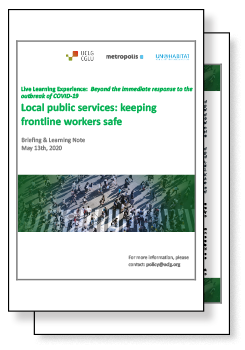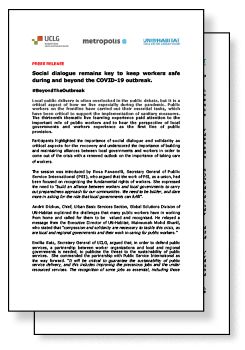Public Service Workers
Secretary General of Public Service International (PSI)
UCLG Secretary General
Under-Secretary-General of the United Nations and Executive Director of UN-Habitat

Context

Public service workers are essential to the proper functioning of a city. They make sure citizens access public goods such as water, sanitation, education and energy and provide fundamental services such as waste management, social and health services, transportation among many others. They also oversee the entire municipal administration, making sure that social programs and public benefits reach the most vulnerable communities. If public workers are a key piece in a city’s engine under normal conditions, their work becomes even more fundamental when we are facing a crisis. The COVID-19 pandemic has thrusted public health officials and other public workers into the spotlight, helping elevate awareness and understanding of the critical role public servants play in everyday life, and in particular during times of severe crises. While most of us were advised to stay home to stay healthy, many of these workers have put their lives at risk and continued doing their job, guaranteeing the safety and well-being of all other urban citizens.
Challenges

Public sector workforces have been asked to work in new ways and new contexts, becoming ‘accidentally agile’, with new procedures and protocols developed with unprecedented speed, all while risking their lives to keep their communities safe. In that context, cities’ main challenge was to provide tools, trainings and equipment to keep service providers safe and healthy. Besides trying to provide protection from the virus, supporting worker’s mental health has also been a key challenge. In that sense, public support and acknowledgement of these efforts demonstrate that their sacrifices are being recognized and help keeping workers motivated to keep fighting. Such acknowledgment needs to be built on an ongoing social dialogue between public service workers and local and national governments. This dialogue will be key to ensure a safe environment to public service workers so that they can resume non-pandemic related service delivery.
Needs

Public workers have clearly expressed their most pressing needs during the pandemic, which include enough personal protective equipment and training; support for workers with longer shifts (such as provision of child care); and emergency benefits such as provisions for working from home, and paid sick leave. Looking ahead, in order to ensure such basic needs to a fundamental piece of our cities’ structure, particularly in times of crises, local authorities need to increase investments in local public services, avoid cutting public budgets and staff as much as possible and establish partnerships with workers’ organizations.
Responses
During the outbreak, Nursultan provided groceries to people who needed them
Public work organizations in Sao Paulo took actions to guarantee that more people could work in public services and reduce the toll on services that were under stress
Responses
During the outbreak, Nursultan provided groceries to people who needed them
Public work organizations in Sao Paulo took actions to guarantee that more people could work in public services and reduce the toll on services that were under stress:
Key Takeaways
- During the crisis, local and regional governments are doing their best to ensure the continuity of essential services and filling in the gaps from national responses. Public service workers perform the daily tasks that these undertakings translate into. As we start to restructure our cities in the post-COVID-19 era, we must ensure that the value of local public workers is properly acknowledged, and continue providing the tools and resources for safe and decent working conditions.
- There must be an ongoing social dialogue between local authorities and public service workers’ representatives. Along with statistical data that will help recognize the safety and health needs of public workers, an engaged collaboration between governments and workers’ representatives will help identify main challenges and effective responses to pressing needs.
- There is an opportunity to turn the challenges posed by COVID-19 to public service provision into building a culture of safety and health rights. Public workers’ associations can leverage on the increased public awareness of the importance of the sector and fight for safer, more decent working conditions.
- On the policy side, national and local governments should work to improve policy coherence, planning and dialogue between government authorities and public services. Together, they should establish policies, measures and working conditions that reinforce territories’ resilience and increase administrative and fiscal autonomy.
Beyond
The Outbreak
Since the 2008 crisis, structural reforms and austerity policies have forced countries worldwide to experience drastic cuts in their national budgets and have been forced to reduce expenses, many times cutting resources to public service workers. When COVID-19 hit, it found health, education and social service workers already under extreme pressure, shedding light on a much-needed conversation: local governments need stronger budgets for public service workers and more autonomy to manage those funds. The outbreak has spurred the debate on “remunicipalisaton” the idea that public services’ budgets should return to local government hands as a way to avoid cuts in budget and staff, ensuring the safety of the latter and guaranteeing that cities and regions are more prepared for crises to come.

Building
Back Better
The UCLG Decalogue

Resources

For further information on the topic of Public Service Workers and its impact on cities and regions, please refer to the related resources included below.
- ITF Charter on PPE and health and safety in public transport
- UCLG Manifesto – The Future of Resilience
- COVID-19 Emergency – PSI priorities and perspectives
- PSI “Beyond health workers, millions more need better conditions to beat Covid19”
- PSI “Sanitation workers play a key role to break the contamination chain”
- PSI “Lockdown pushes digitalisation through in Italian public services”
- PSI “Stronger public services through remunicipalisation: building a resilient post-Covid-19 world”
- ILO International Labour Standard on Employment and Decent Work for Peace and Resilience Recommendation
- ILO Guidelines on decent work in public emergency services
- ILO Sectoral Brief: COVID-19 and public emergency services




